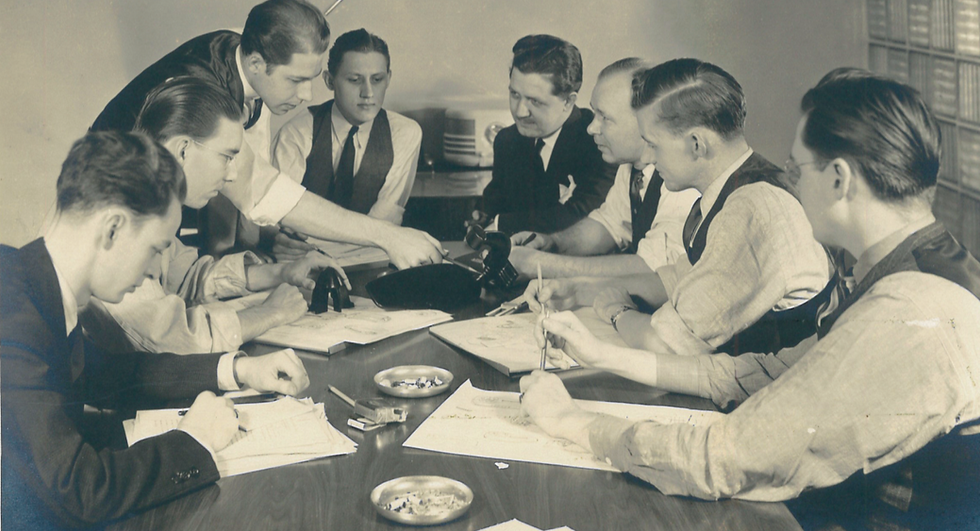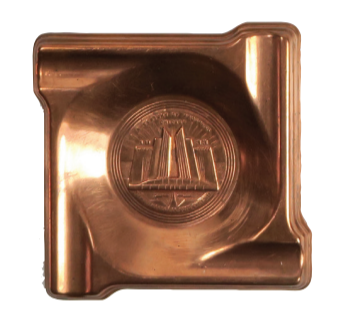It Started with an Ashtray
- Vicki Matranga

- Apr 13, 2021
- 7 min read
Updated: May 11, 2021
by: Vicki Matranga
1933 and 1934 Chrysler souvenir ashtrays
Just as the 1871 fire drew architects and engineers to Chicago to rebuild the city, so too the planning of the 1933–34 Century of Progress exposition attracted designers. Eager to work with the many companies that would build displays, Jean Otis Reinecke (1909–1987) and James Barnes (1908–1986) came from St. Louis to Chicago in 1930 to set up a branch office for their employer, General Displays, Inc. While Reinecke was the artist, Barnes was the salesman.
Reinecke revealed his artistic skills and entrepreneurial energy while in high school in Pittsburg, KS. He picked strawberries on the family farm and delivered newspapers to earn money to buy his own horse, worked in a sign painting shop and partnered with a classmate to build and repair radios. After graduating from high school in 1926, he attended one semester at Kansas State Teachers College. He worked as an illustrator for a nearby publisher and then left for St. Louis in 1927 and took a few art courses at Washington University. He began working at General Displays where he designed displays for conventions and store windows and illustrated advertising posters, magazines and promotional stickers. He designed an exhibit of an amphibian plane at the international aircraft exposition in St. Louis in 1929, and in 1930, at the company’s new branch office, he created posters for the national air races held in Chicago. Little is known about James Barnes outside the pair.
Creating Classics for American Consumers
While hunting for clients, the ambitious pair visited factories and fabricators to learn about the latest production techniques. While designing and managing displays for some 25 companies exhibiting at the Century of Progress, Reinecke and Barnes also learned about merchandising
and brand image. In addition to designing displays for the Chrysler Pavilion, they redesigned the automaker’s 1933 souvenir ashtray and its packaging for the fair’s 1934 season. Reformatted from a square to a circle, the updated ashtray improved on functionality, replacing the narrow four corner grooves with one wide slot for the resting cigarette. A much clearer presentation of the Chrysler Pavilion and the company’s four auto brands, the ashtray also emphasized the building’s dramatic appearance at the 1934 Century of Progress. Similarly, its mailer package was a much stronger graphic brand statement.
At the same time, Barnes and Reinecke began designing products for local manufacturers, such as the Chicago Electric Mfg. Co. They designed a toaster for the firm, which sold through the 1930s, and for which in February 1934 they applied to patent their design. Fortuitously, the
article “Both Fish and Fowl” appeared in the February 1934 issue of Fortune magazine. This article proved to become a great influence for business and design as it credited the emerging industrial design profession for increasing product sales. It featured New York designers such as Raymond Loewy, FIDSA, Walter Dorwin Teague, FIDSA, and Henry Dreyfuss, FIDSA, who commanded fabulous fees. Encouraged by such exciting opportunities in the new field, Reinecke and Barnes bought the General Displays office and established General Exhibits and Displays in 1934. They sold the enterprise in 1935 to launch the Barnes & Reinecke industrial design firm and settled into an office at 664 North Michigan Avenue. Similar to the self-made founders of today’s start-up companies, the bold Reinecke was 26 years old.
Regional manufacturers and their suppliers provided the firm with a ripe field of potential clients hungry for new directions as Barnes & Reinecke educated them on how designers operate. Within 10 years, Barnes & Reinecke became the largest design office in Chicago, serving companies throughout the Midwest and beyond. Its staff designed numerous products considered icons in their categories. In 1938, Reinecke’s redesign of a heavy-duty Scotch tape dispenser for the Minnesota Mining and ManufacturingCompany (3M) increased sales by 53 percent over the previous year and began Reinecke’s 40-year relationship with the company. The compact plastic dispenser designed in 1939 is still common on desks today. The 1B14 model Toastmaster, for the McGraw-Edison Company of Elgin, IL, created the type form for the modern toaster and was the top seller in the postwar market. The design team also created the wavy emblem of the electrical resistor coil placed on the curved chromium surfaces to disguise production imperfections or wear. This graphic element remained the Toastmaster logo for decades.

Promoting Materials and Results
Barnes & Reinecke were early advocates in Chicago, serving companies throughout for the latest materials and processes. They understood the many benefits of the new plastic materials, which could create fluid forms in appealing colors to entice consumers and result in higher sales while delivering manufacturing efficiencies, such as reducing the number of parts in a product.
The magazine Modern Plastics premiered in 1934, and Reinecke frequently contributed articles that explained the materials’ flexibility and applications. The firm’s entries to the magazine’s annual product competition often ranked among the winners. The office also illustrated molding processes for the magazine’s 1947 Engineering Design for Plastics Encyclopedia.

Barnes & Reinecke design team. Reinecke, standing; VP of design David Painter at head of table (wearing vest) with Barnes (in dark suit). February, 1940 "Future magazine."
Barnes & Reinecke promoted their skills and the success of their clients’ redesigned products with before and-after comparisons in advertising mailers sent to prospective clients and with articles in trade publications read by decision-makers. For example, for the Miller Hydro Company in Bainbridge, GA, they redesigned a bottle washing machine to make it more efficient and streamlined in appearance and described their approach in a 1939 issue of the National Bottlers’ Gazette. In 1940 Barnes and Reinecke were described in Today’s Young Men, a book featuring profiles of 70 “inexperienced young men unhampered by precedent” who were achieving success in many fields and leading the way out of the Depression. Barnes and Reinecke, the author wrote, “are changing the entire appearance of the environment in which we work and play, and—more amazing—are causing a multitude of long established manufacturing principles to be tossed in the discard. Scores of the nation’s large, well-established, long experienced companies, faced by diminishing consumer markets the past ten years, have turned to Barnes and Reinecke, industrial designers, for a way out of the red.”

Barnes & Reinecke sales brochure, c. 1946.
Design Evolution in the 1940s
During World War II, the firm’s staff swelled to more than 325 as it embedded its engineers at clients’ plants to create items serving military needs. The firm worked on many secret research projects for the armed forces and provided crews of engineers and designers to furnish packaged production services to eliminate war-plant bottlenecks. The firm also designed numerous futuristic products for the imagined postwar consumer economy to keep its name in the public eye. In 1946 the firm mounted a national marketing campaign to attract new postwar clientele; its staff then numbered 181, and the firm had grossed $1.4 million in sales the previous year. Articles about the firm’s work appeared in trade journals and the consumer press, notably an October 1946 issue of Life, the country’s most popular family magazine.
In 1946 its sales brochure (shown above) headlined the firm’s credo: “Design Increases Sales.” The back cover featured four large products: a Bucyrus-Erie construction shovel, a Firestone home laundry washing machine, an Allis-Chalmers tractor and an electric carpentry tool for the Milwaukee Saw Trimmer Corp. The inside message read, “A fact worth remembering: Our facilities, experience and knowledge of Merchandising, Materials and Manufacturing Techniques cannot be surpassed.” The colorful array of small products included products for many Chicago-area manufacturers and distant companies: a drink mixer and juice extractor for the Scoville Mfg. Co. (Waterbury, CT), a slide projector and movie camera for Bell & Howell (Chicago), an automobile heater and portable radio for Motorola (Chicago), an ice crusher and juice extractor for Dazey Corp. (St. Louis), the Toastmaster hospitality set and waffle baker set for the McGraw-Edison Co. (Elgin, IL), tape dispensers for 3M (St. Paul, MN), an electric guitar for Gibson (Kalamazoo, MI), and a desk lamp and pen set for the W.A. Shaeffer Pen Co. (Fort Madison, IA).
The Barnes & Reinecke Legacy
In 1948 the partnership ended and Jean Reinecke, along with the firm’s key designers, formed J.O. Reinecke and Associates. As the design team continued together, the new firm could rightly claim to have designed profitable products from A (adding machines) to almost Z—they only reached Y (yacht chairs), jokingly “offering a bargain to some zither manufacturer.” The hand dryer the firm designed in 1949 for Chicago’s National Dryer Corp. still appears in restrooms across the country and had no serious competition until the appearance of the Dyson Air Blade, about 60 years later.
The booming postwar economy offered fresh prospects for designers. By 1952, Reinecke’s four main associates opened their own offices. David Painter, who had joined Barnes & Reinecke in 1936, joined with James Teague and Victor Petertil to form Painter, Teague, Petertil. The trio designed the first transistor radio, the Regency TR-1, in 1954. Jon W. Hauser designed midcentury classic products at his solo practice, which he operated for 35 years serving numerous long-term clients. In March 1958, at the invitation of the Industrial Arts Institute in the Ministry of International Trade and Industry of Japan, Reinecke taught a two-week industrial design course in Tokyo. He later advised the institute on sources of information in the U.S. and suggested subsequent lecturers. Jean Reinecke continued to operate his Chicago office and opened a satellite location in California in 1959, relocating there in the 1970s.
Barnes & Reinecke, along with the design departments established at retailers Montgomery Ward in 1932 and Sears, Roebuck in 1934, formed the trunk of the Chicago family tree of industrial design. These three employers, established during the Art Deco period, trained designers whose heirs continue to practice around the country and in Chicago design offices to this day.
This article first appeared in the Winter 2017 issue of INNOVATION, published by the Industrial Designers Society of America (IDSA)











Comments